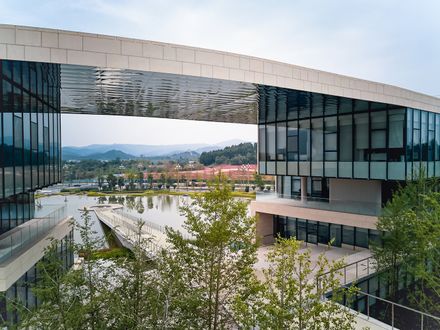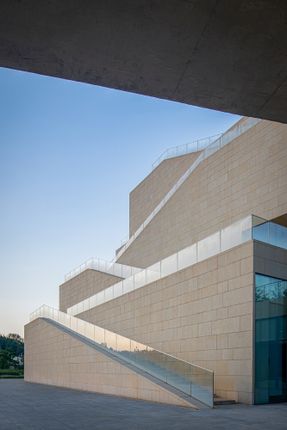
Window of Kaizhou Museum
ARCHITECTS
BIAD + ZXD Architects
LEAD ARCHITECT
Zhu Xiaodi
CLIENT
Deyang Kaizhou Investment And Development Co.
INTERIOR DESIGN
Biad Decoration Engineering & Design Co., Ltd, Shi Shanshan, Yang Zilin - Biad Decoration Engineering & Design Co., Ltd
LIGHTING DESIGN
Puri Lighting Design, Hu Fang, Li Yahui - Puri Lighting Design (Puri)
DESIGN TEAM
Jia Qi, Luo Pan, Sun Xiaoqian, Sun Biaozhu, Wang Ye, Ma Yibo, Li Xiaoying, Wang Xiaodong
MANUFACTURERS
Chengtai Stone Industry Co, Dianyue Building Materials Technology Co., Wangqing Stone
PROGRAM
Cultural Architecture / Museum & Exhibit / Exhibition Center
EQUIPMENT
Cui Yue
STRUCTURE
Chen Han, Yin Fei
YEAR
2023
LOCATION
De Yang Shi, China
CATEGORY
Museums & Exhibit, Exhibition Center
Window of Kaizhou - The Kaizhou New Town Planning Exhibition Hall -
The Kaizhou New Town Planning Exhibition Hall (Window of Kaizhou) is located within the start-up zone of the Kaizhou new town, adjacent to the intersection of the two axes of the new town.
The horizontal axis is the People’s Canal Park, which is the core landscape belt of the start-up zone. The vertical axis is the Zhongjiang – Jintang expressway, which is the belt connecting the new urban agglomerations.
Being located in the leading development zone of the new town means that the exhibition hall is not only an important public space of the new town but also the most direct display window of the new town to the outside world.
This exhibition hall is located on the east of the Zhongjiang – Jintang expressway, with a total land area of about 14,000m2. It is adjacent to a lotus pond on its west, and the hill on its east.
The People’s Canal runs through the top of the hill. This site is thereby characterized by local natural landscape features. There was a path extending from the hill on the east into the valley of the village, which had been expanded as the main road to the exhibition hall.
The site takes advantage of the landscape features both of the natural landscape (lotus pond) and the human landscape (the People’s Canal). The beautiful lotus pond is a continuation of the rural landscape of traditional agricultural society, while the People’s Canal is the witness to human production activities in a specific historical period.
The architect believes it is necessary to reconsider the relationship between humans and nature when developing the new town, which shall respond to the specific environment of the site and activate the existing space-time elements to achieve an accurate design intention.
According to the functional requirements, a 20m-high and 100m-long building is placed on the site as the basic volume. A bridge is designed that goes through the building and connects the lotus pond and the hill, which forms a cross dialogue with the building volume.
A large-scale window opens in the middle of the building volume forming an outdoor public space, strengthening such dialogue, and highlighting the concept of the window.
The bridge through the window allows visitors to establish a connection between the lotus pond and the hills, using the building as a window to view nature.
The landscape field, which is not originally grand and unique, is visually constrained and released through the observation of the window, it hints at the existence of the landscape scene and enables the visitor to gain a new psychological experience.
The whole project is comprised of the four-story exhibition hall as the main body and a staff canteen on the north side. The exhibition hall consists of the south volume and the north volume, both of the volumes are equipped with independent entrances and exits as well as a vertical transport system.
The entrance hall on the first floor is the key space that connects the south and north volumes and also serves as the main entrance and reception. On this floor, the conference area and exhibition storage area are located in each volume.
This building is divided into two volumes from the second floor which are joined together again at the roof level. The “window” in the middle is an open outdoor platform.
On the north volume, the second to the fourth floors are the office areas. On the south volume, the second to the third floors are the planning exhibition areas, and the fourth floor is the office area.
The window openings are mainly on the east elevation to provide sufficient light and ventilation for the different functional spaces. The west elevation serves as the main display surface while avoiding western exposure with a “solid” surface.
The volume of the stone forms the outdoor terraces which are set back layer by layer. The interlaced steps connect with the terrace of each floor and become a concise and continuous path that goes through the facade toward the roof platform.
Therefore, it can relieve the vertical transport for the evacuation purpose and reduce the redundancy of the interior transport space, and in the meantime, weakens the oppressing sensation of the building volume and brings more changes.
More importantly, the design further mobilizes the movement path of the visitors and allows them to experience the building and the surrounding environment from different perspectives in the vertical direction and at the height of the roof. Therefore, it can be considered a platform through which visitors may witness the urban development process in a realistic scenario.
Visitors are walking, pass through and climb in this building. By integrating humans, architecture, and nature into a picturesque scene, it becomes the liveliest urban stage and “a window of the future” that shows the landscape and culture of the Kaizhou new town.




































